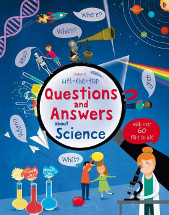Lift-the-flap questions and answers about Science by Katie Daynes

Lift-the-flap questions and answers about Science by Katie Daynes
Ill. by Marie-Eve Tremblay. Usborne, 2016. ISBN 9781409598985
From the time they are born children are innately curious and as
soon as they are able to articulate the words, they ask questions so
they can make the connections they need as they try to make sense of
their world. As the nearest adult we try to help them with the
answers. Some of the answers are at our fingertips but some need a
little more digging.
Often those answers lie in science and this book is a great
introduction for the budding young scientist who has the questions
and wants a basic explanation that can be followed further if they
wish. Just 16 pages long, it is divided into double page spreads
with the headings what, why, when, where, which, who, how and yes or
no. Each page has several questions, the answers for which are
hidden under the flaps. Starting with the basic "What is science?"
and "What do scientists do?" it goes on to explore other questions
about science itself as well as others such as "Is the sky really
blue?" Simple explanations and quirky pictures under the flaps
provide a straight-forward answer as well as the starting point for
further investigations. Having the answers under the flap gives the
child an opportunity to consider the question and then suggest their
own explanation before checking to see if they are on the right
track.
Aimed at the young reader with an interest in science, nevertheless
it is a book to be shared with a grownup who can help with some of
the words, interpret the answers more fully and suggest other
sources for finding out more including the Usborne
web page for the book which has more questions, links to websites
and other books in the series that delve deeper.
Books like this start the young child on their way to being
information literate - able to locate, evaluate, analyse, interpret
information so they can then use it to satisfy their curiosity,
discover the world around them and ask new questions. With the
current emphasis on STEM (science technology, engineering and maths)
in the school curriculum not only does this book provide answers,
it demonstrates that those answers can be found in print as well as
modelling how to ask questions that require more than a one-word
answer to take an investigation further.
It could even be the springboard for an ongoing class activity with
a question posed each week so students can share their answers which
are then compared to the explanation provided, discussed and
investigated, sparking an interest in science that endures.
This is a dip-and-delve book - one the reader will come back to time
and time again.
Barbara Braxton